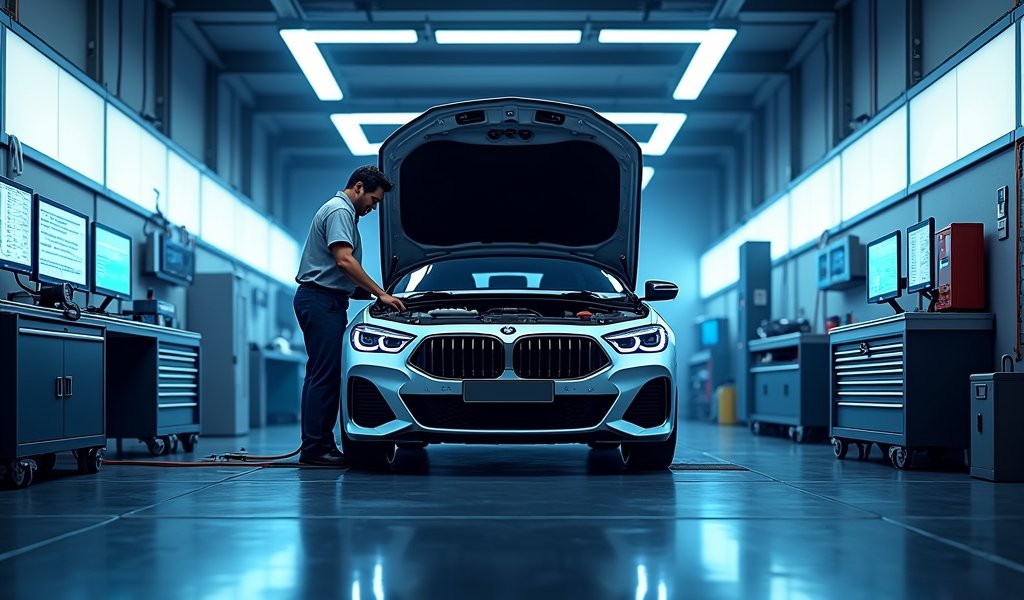Overview
This article provides five essential tips for car diagnostic services: knowing when to get diagnostics, finding a trustworthy technician, understanding the diagnostic process, asking the right questions, and following up after repairs. It emphasizes that modern car diagnostics require specialized knowledge and equipment, with proper diagnostic services saving money by preventing minor issues from becoming major repairs.
Table of Contents
- Understanding Car Diagnostic Services
- Why Car Diagnostics Matter
- Tip 1: Know When to Get a Diagnostic
- Tip 2: Find a Trustworthy Technician
- Tip 3: Understand the Diagnostic Process
- Tip 4: Ask the Right Questions
- Tip 5: Follow Up After Repairs
- DIY vs. Professional Diagnostics
- Cost of Car Diagnostic Services
- Conclusion
- Frequently Asked Questions
Understanding Car Diagnostic Services
Your car is smarter than you might think. Modern vehicles pack dozens of computers and sensors that continuously monitor everything from engine performance to tire pressure. When something goes wrong, these systems generate error codes that help pinpoint the problem.
A car diagnostic service taps into these systems to read those codes and interpret what your vehicle is trying to tell you. Think of it as your car speaking a language only trained professionals understand.
I’ve spent 20 years under the hood, and I can tell you that a proper diagnostic isn’t just about scanning for codes. It’s about interpreting them correctly and understanding the story they tell about your vehicle’s health.
The right diagnostic service saves you time, money, and prevents those small issues from becoming major headaches. Let me walk you through what you need to know about getting the most from a car diagnostic check.
Why Car Diagnostics Matter
Remember when cars were simple enough that you could fix most problems with basic tools and know-how? Those days are gone. Today’s vehicles are rolling computers that require specialized equipment to diagnose properly.
Car diagnostics matter because they:
- Identify problems before they cause breakdowns
- Save you money by preventing minor issues from becoming major repairs
- Improve fuel efficiency by keeping systems running optimally
- Extend your vehicle’s lifespan through proper maintenance
- Ensure safety by catching critical failures early
I’ve seen countless customers ignore warning signs until they’re stranded on the highway. Don’t be that person. Regular diagnostics catch issues while they’re still small and manageable.
According to AAA research, neglecting minor issues can lead to repair bills that are 10 times higher than addressing problems early. Your wallet will thank you for being proactive.

Tip 1: Know When to Get a Diagnostic
Your car communicates with you more than you might realize. Learning to recognize these signals can save you from costly repairs down the road.
Get a diagnostic scan immediately when you notice:
- The check engine light comes on (steady or flashing)
- Strange noises, especially from the engine or transmission
- Unusual smells (burning, sweet coolant, rotten eggs)
- Decreased fuel efficiency
- Rough idling, stalling, or hesitation during acceleration
- Handling issues like pulling to one side or vibrations
That check engine light isn’t there for decoration. When it illuminates, your car is telling you something’s wrong. If it’s flashing, pull over safely—it indicates a severe problem that could damage your catalytic converter if you keep driving.
Don’t wait for symptoms to worsen. The check engine light can indicate dozens of different issues, from a loose gas cap to serious engine problems. Only a proper diagnostic can tell you which you’re dealing with.
Even if your vehicle seems to be running fine, I recommend a diagnostic scan during your regular maintenance schedule—typically every 10,000 miles or once a year. This preventative approach catches issues before they become noticeable problems.
Tip 2: Find a Trustworthy Technician
Not all diagnostic services are created equal. The difference between a basic code reader and a comprehensive diagnostic can mean thousands in unnecessary repairs or missed problems.
When searching for a technician, look for:
- ASE certification (Automotive Service Excellence)
- Manufacturer-specific training for your vehicle make
- Up-to-date diagnostic equipment (not just a basic code reader)
- Positive reviews mentioning accurate diagnostics
- Willingness to explain findings in plain language
Finding a certified car mechanic near you might take some research, but it’s worth the effort. A skilled technician doesn’t just read codes—they interpret them in context with your vehicle’s history and your driving patterns.
Ask friends for recommendations or check reputable online platforms like the ASE’s certified professional directory. Dealership service departments usually have manufacturer-specific training and equipment, which can be crucial for complex modern vehicles.
Remember, the cheapest diagnostic isn’t always the best value. Quality diagnostics might cost more upfront but save you from misdiagnosis and unnecessary parts replacement.
Tip 3: Understand the Diagnostic Process
A proper car diagnostic service involves much more than just plugging in a scanner. Understanding the process helps you know whether you’re getting thorough service.
Here’s what a comprehensive diagnostic typically includes:
- Initial discussion about the symptoms you’ve noticed
- Visual inspection of relevant components
- Connection to the OBD-II port to retrieve error codes
- Analysis of live data streams from various sensors
- Verification testing to confirm the diagnosis
- Explanation of findings and repair recommendations
The OBD-II (On-Board Diagnostics) port is usually located under your dashboard near the steering column. This standardized port has been required on all vehicles sold in the US since 1996.
A good technician will explain that diagnostic trouble codes (DTCs) are starting points, not final answers. For example, a P0301 code indicates cylinder 1 is misfiring—but the underlying cause could be bad spark plugs, ignition coils, fuel injectors, compression issues, or vacuum leaks.
That’s why verification testing matters. I’ve seen countless customers who had parts replaced based solely on error codes without proper verification, only to have the same problem return.

Tip 4: Ask the Right Questions
Being an informed customer helps you get better service. Don’t be afraid to ask questions—good technicians welcome them.
Key questions to ask during a diagnostic service:
- What specific codes appeared during the scan?
- Can you explain what these codes mean in simple terms?
- How confident are you in this diagnosis?
- What verification tests did you perform?
- Are there any related issues I should know about?
- What happens if I delay this repair?
- Is this repair absolutely necessary or just recommended?
Take notes during these conversations. A technician who struggles to explain findings clearly may not fully understand the problem themselves.
Don’t hesitate to ask for evidence. If they tell you a part is worn or damaged, ask to see it. Most honest shops are happy to show you the problem parts.
If you’re quoted a substantial repair, consider getting a second opinion. This isn’t questioning anyone’s integrity—it’s being a prudent consumer with a potentially expensive purchase.
Tip 5: Follow Up After Repairs
The diagnostic and repair process doesn’t end when you pay the bill. Proper follow-up ensures the problem is truly resolved.
After repairs are completed:
- Request a post-repair scan to verify all codes are cleared
- Take a test drive with the technician if possible
- Understand what “normal” should feel like now
- Know what symptoms would indicate the problem isn’t fixed
- Schedule any recommended follow-up checks
Many vehicle issues require a “reset period” where the car’s computers relearn their parameters. Your technician should explain if your specific repair needs this adaptation time.
Keep all paperwork related to your diagnostic and repairs. This documentation creates a valuable history for future troubleshooting and can increase your vehicle’s resale value by demonstrating proper maintenance.
If the problem returns after repair, contact your shop promptly. Reputable shops stand behind their work and will want to make it right.
DIY vs. Professional Diagnostics
With affordable OBD-II scanners available at auto parts stores and online, you might wonder if you need professional diagnostics at all.
Consumer-grade scanners have limitations:
- They typically read only generic codes, not manufacturer-specific ones
- They don’t access all vehicle systems (ABS, airbags, transmission, etc.)
- They provide codes without context or interpretation
- They can’t perform bidirectional controls for testing components
- They lack access to technical service bulletins and known issues
That said, a basic scanner can be useful for initial troubleshooting. If your check engine light comes on, a quick scan can tell you whether it’s something simple like a loose gas cap or something requiring immediate attention.
Professional diagnostic equipment costs thousands of dollars and requires training to interpret results properly. According to the Bureau of Labor Statistics, automotive technicians typically need several years of training to master diagnostic procedures.
Think of DIY scanning as a first step, not a replacement for professional diagnosis when dealing with complex issues.
Cost of Car Diagnostic Services
Understanding typical costs helps you budget appropriately and recognize when you’re being overcharged.
Diagnostic fees typically range from:
- Basic code reading: $0-50 (often free at auto parts stores)
- Standard diagnostic service: $75-150
- Comprehensive diagnostic with specialized equipment: $150-300
- Advanced manufacturer-specific diagnostics: $200-500
Many shops apply the diagnostic fee toward repair costs if you have the work done with them. Some issues require multiple diagnostic hours due to their intermittent or complex nature.
Remember that paying for quality diagnostics often saves money in the long run by preventing misdiagnosis and unnecessary parts replacement. I’ve seen customers spend hundreds replacing parts that weren’t actually causing their problem because they skipped proper diagnostics.
Always get a clear explanation of what the diagnostic fee includes and whether it will be applied to repair costs.
Conclusion
Your vehicle is likely one of your most valuable assets. Treating car diagnostic services as an investment rather than an expense can save you thousands in the long run.
When your car speaks through warning lights and unusual symptoms, listen carefully. Find a qualified technician who can translate those signals accurately. Ask questions, understand the process, and follow up appropriately after repairs.
The five essential tips we’ve covered—knowing when to get diagnostics, finding a trustworthy technician, understanding the process, asking the right questions, and proper follow-up—form the foundation of smart vehicle ownership.
Remember that modern car diagnostics is both an art and a science. The right combination of advanced equipment and experienced interpretation makes all the difference between a quick, accurate fix and a frustrating cycle of recurring problems.
Take care of your vehicle with regular maintenance and prompt attention to warning signs, and it will take care of you with years of reliable service.
Frequently Asked Questions
How often should I get a car diagnostic scan?
Get a scan whenever warning lights appear or you notice performance issues. As preventative maintenance, schedule one annually or every 10,000 miles.
Can I just use a code reader from an auto parts store instead?
Basic code readers help identify simple issues but miss manufacturer-specific codes and can’t test components. They’re useful for preliminary checks but not comprehensive diagnostics.
How long does a car diagnostic service take?
A basic scan takes 15-30 minutes, while comprehensive diagnostics may require 1-2 hours. Complex or intermittent issues might need longer monitoring periods.
Will a diagnostic tell me exactly what’s wrong with my car?
Not always. Diagnostics identify the reported fault or system, but further testing is often needed to determine the root cause. Think of codes as clues, not final answers.
Can a car pass inspection with the check engine light on?
Generally, no. Most state inspections automatically fail vehicles with active check engine lights since they indicate emissions or safety issues that need addressing.


Pingback: Engine Coolant Temperature Sensor 7 Tips - knowsyourcar.com
Pingback: Evaporative Emission Control Canister - knowsyourcar.com
Pingback: Planetary Gear Set Inspection: 5 Tips - knowsyourcar.com
Pingback: Brake Booster Vacuum Test: 5 Best Fixes - knowsyourcar.com